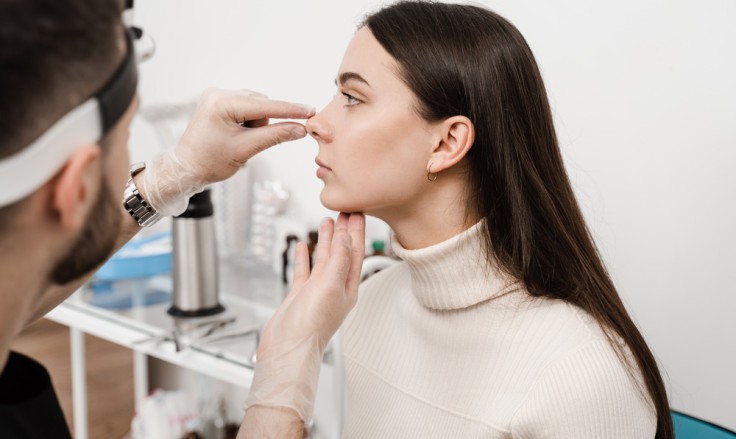Deviated septum surgery is a procedure designed to correct a misaligned nasal septum. The septum is the thin wall of cartilage and bone that divides the two nostrils. When it is crooked or displaced, breathing becomes more difficult. Many people will experience congestion, snoring or frequent sinus infections as a result. Deviated septum surgery, also called septoplasty, reshapes or repositions the septum for improved airflow. Read on to explore the benefits patients can expect from deviated septum surgery.
What is a Deviated Septum?
A deviated septum occurs when the wall between the nostrils is off-centre. For some, the condition is present from birth. For others, it develops after injury or gradual changes over time. A significant deviation may block airflow through one or both nostrils. Common symptoms include congestion, difficulty sleeping, or frequent sinus problems. Some mild deviations may not require treatment. But, more severe cases will often benefit from having deviated septum surgery. Correcting the alignment helps restore clear breathing and improves quality of life.
Why Do People Choose Deviated Septum Surgery?
The most common reason for deviated septum surgery is difficulty breathing. Patients often describe always feeling “blocked” on one side of the nose. Others struggle with chronic sinus infections, headaches, or disrupted sleep. Snoring is also a frequent complaint, which can affect both the patient and their partner. By correcting the septum, airflow will improve. ~This leads to better breathing day and night. Altogether, the surgery is chosen for both medical and lifestyle reasons, offering relief and comfort.
Preparing for Deviated Septum Surgery
Preparation begins with a consultation with an ear, nose and throat specialist. During this appointment, the surgeon examines the nasal passages and discusses symptoms. Imaging or endoscopy may be used to view the septum in detail. First patients will be asked about medical history, allergies, and current medications. Ahead of surgery, smoking should be avoided and certain medicines might have to be paused. Clear instructions are given to prepare for a smooth experience. Additionally, patients are encouraged to arrange transport home after the procedure.
What Happens During The Procedure?
Deviated septum surgery is usually performed under local or general anaesthesia. The procedure takes around one to two hours. The surgeon makes small incisions inside the nose, so no external scars remain. The cartilage and bone of the septum are then repositioned or reshaped. In some cases, small amounts of tissue may be removed. Finally, the septum is straightened, and the nasal passages are cleared. Splints or soft dressings may be placed inside the nose to support healing. Overall, the process is carefully managed to restore balance and function.
Recovery After Deviated Septum Surgery
Recovery is straightforward, but it does require patience. Patients often return home the same day. Mild swelling, congestion, and stuffiness are common during the first week. Surgeons usually schedule a follow-up to remove splints or dressings. Most people return to light activities within a week, though strenuous exercise is delayed. Breathing often improves gradually as healing continues. By a few weeks, patients notice clearer airflow, reduced snoring, and improved sleep. Patients find that recovery is manageable, with steady improvement as the nose heals.

What Are The Benefits?
The benefits of deviated septum surgery are both functional and lifestyle-related. Improved airflow is the most obvious outcome, making breathing easier. Many patients also report fewer sinus infections and less nasal congestion. Reduced snoring is another key benefit, allowing for a better sleep. Additionally, relief from chronic headaches or facial pressure is common. Beyond health improvements, patients often feel more energised and less fatigued.
Cost of Deviated Septum Surgery
The cost of deviated septum surgery in 2025 varies by region and clinic. In the UK, private treatment typically costs between £3,000 and £6,000. In the USA, costs may rise to £7,000 or more. Turkey, known for high-quality medical tourism, offers the procedure at around £2,000 to £4,000. Costs usually include anaesthesia, hospital facilities, and aftercare. Prices may also differ if septoplasty is combined with cosmetic rhinoplasty. Altogether, the financial investment reflects both surgical expertise and long-term benefits.
Long-Term Outlook After Deviated Septum Surgery
Deviated septum surgery offers enduring improvements that extend far beyond the nose itself. Once the septum is straightened, breathing improvements remain stable for many years. Some patients notice immediate changes, while others experience gradual improvement over weeks. Many will experience almost-immediate lifestyle benefits, such as reduced snoring and better sleep. Importantly, the enhanced airflow contributes to improved overall wellbeing. With appropriate care and follow-up, results typically last a lifetime.
Deviated Septum Surgery vs Rhinoplasty
Although deviated septum surgery and rhinoplasty are often mentioned together, they serve different purposes. Deviated septum surgery, or septoplasty, focuses on correcting function. The goal is to straighten the septum and improve airflow. Rhinoplasty, on the other hand, is primarily cosmetic, reshaping the nose to enhance appearance. It is possible for both procedures to be performed together, addressing function and aesthetics simultaneously. Who will benefit from a combined treatment? Patients that struggle with breathing but are also unhappy with the shape of their nose. Understanding this distinction helps patients decide whether they need septoplasty, rhinoplasty or a combination.
Conclusion
Deviated septum surgery is a safe, effective procedure for those struggling with blocked nasal passages. Patients will enjoy clearer breathing, better sleep and reduced sinus problems. Costs vary worldwide, but the benefits are long-term and transformative. Understanding what deviated septum surgery involves helps patients feel informed and confident.
For more information and to book a consultation visit the ACIBADEM Beauty Center webpage.
Frequently Asked Questions
The procedure usually lasts one to two hours, depending on complexity.
No, incisions are made inside the nose, leaving no external scars.
Light activities can resume within a week, but strenuous exercise should wait longer.
Yes, results are generally permanent, with improved airflow lasting for many years.
Septoplasty focuses on function, though some patients notice subtle cosmetic improvements.














